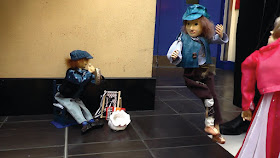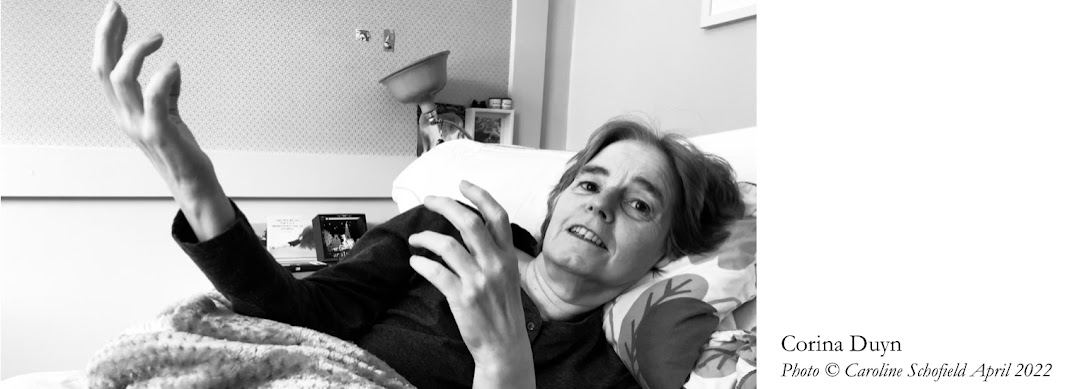Living in the shadows of an Invisible Octopus
Working on ‘Invisible Octopus’ inexplicably forced me
to examine and establish
the truth about what is my normal.
 |
| First day of mentoring in my studio. Me (Corina Duyn), Emma Fisher and Aram Wahhoud (photo my Marwa Wahhoud) |
In this paper, which I will share in sections over the coming week, I explore the background to ‘Invisible Octopus’ and the challenges, opportunities and personal revelations it brought.
Copyright:
* Abstract may be quoted, but please reference the source: 'Invisible Octopus', Corina Duyn, 2019. www.corinaduyn.blogspot.ie, (please include direct link) and date accessed. And it would be great to hear from you where you have used my writing. Thank you
Can I become the hand over M.E. and have control over me?”
I have been a
puppet maker all my life, but the design and emphasis has changed significantly
in recent times. I became a full time Doll Artist after my move to Ireland in
1989, which followed my time working as a palliative care nurse and social care
worker in my native Netherlands. My medium is air-drying clay, which allows me
to create very delicate detail in facial features, as well as hands and feet.
My Fantasy Folk Artist Dolls and Puppets were fantasy figures, and reflections
on life around me.
In 1998 I
taught puppet making in a group home for teenagers. One fun and engaging young
man of about thirteen sculpted a clown’s head. In complete
contrast to the funny faced he sculpted; the puppets hands were made as fists. This experience
became the pivotal moment where I realized the power of art, especially the
power of working with clay. The clay does not lie. Our
deepest fears, joy, wishes and challenges appear from our hearts
and minds, and make their way through our hands into
the clay. Unfortunately, I did not get to finish
the project with the young people as I became very ill with the neurological
illness Myalgic Encephalomyelitis (M.E.).
In a very short
time I lost the ability to look after myself, to walk properly, to sit up and
talk, to remember, to read, to write, to prepare my food, or do even such
simple tasks as open a tube of toothpaste. I lost all my finer
motor skills to hold my tools and to manipulate the clay. As a
result, my creative output changed dramatically both in substance and
intensity. No longer reflecting on life around me, I examined my
innermost thoughts.
Initially I was only able to do very quick sketches or write a few
words. Over the years I created a visual and written account of this journey
through illness, using whatever materials and methods accessible
to me at any given time, eventually returning to my love of sculpting and
becoming a writer along the way.
One of
my early drawings was that of a marionette. These words
were scribbled over the image: -
“A
puppet, not a great drawing, but…the puppet is me with M.E., I have little or
no control over my body. WHO is the hand who keeps me upright, makes me walk,
makes me move gracefully, or lets me stumble at times, makes me stand my
full length or lets me buckle at the knees, makes the arms move or leaves
them hang like useless objects.
Who is the hand that has control?
What is the hand that holds the cross and moves 'my'
strings at its will?
Can I become the hand over M.E., have control over me?
Hand, whatever you do, don't drop me altogether, hold on, but
stop playing tricks…”
This early reflection
undoubtedly, but subconsciously, influenced my puppetry work in more recent
projects.
Disability Puppetry Project Life Outside the Box
 |
| still from Life Outside the Box film |
After accepting
that full recovery was not within my grasp (2012), I fulfilled a long-held dream to attend
a part-time college course in Disability Studies. A year or so later I became
an active member of the Irish Wheelchair Association (IWA – an organization
for people with physical disabilities). While attending the IWA Resource
Centre, the then Centre coordinator asked me to facilitate a puppet-making
project. We received funding from the ‘Create - Artist in the Community Scheme’, funded by the Arts Council of Ireland. Our group consisted
of 12 people with a variety of disabilities: acquired brain injury, MS, polio,
congenital birth defects, and M.E. Ages 27 to 72. Over the course of eight
months we created nine marionette puppets, a large ‘disability’ box, and a
large hand to help the puppets out of the box. Perhaps this
is the hand in my puppet drawing…
We documented
our project in a blog, a book, and a short film in which our puppets are
stepping out of society’s disability box. Knowing the
participants in advance of the project, I was able to adapt tools and work
methods to suit their specific needs. For one young woman who has no lower arms
but is still able to hold a pen, I created a workstation to enable her to sculpt most
of
her puppet. I also adapted the cross so she could animate her beautiful
finished puppet. Another participant, a man
with an acquired brain injury, felt uncomfortable working in the large group, so
I supported him working one-to-one with him on the large paper-maché hand. It was
encouraging to see the pride in his work and hear him make the
connection with having worked as a chef.
Over the course
of the project I witnessed a shift in focus from disability to ability. Skills
were explored and exchanged and as a result the group became more cohesive.
Each week the puppets’ personalities and stories became more
profound. One participant said that his puppet took on its ultimate personality
because of the obstacles he faced along the way. Being in this group,
busy with our hands, there was a great sense of ease to talk about our lives,
our challenges and hopes. It was a safe place. We certainly laughed a lot too,
which was a great tonic. We all had staff members to support us with practical
work. For me, this made it possible to teach again after a 17-year gap.
“Whilst the
project was about puppets coming out of their box it was the service users that
also ‘came out of their box’ to realise they could do
more than they thought they were capable of. It was the most inclusive project
that we ever did.”
Andrea Lloyd, Centre Coordinator at time of the project.
We filmed Life Outside the Box in our local shopping
centre. We specifically chose this location to seek
interaction with the public. People engaged with us, often by way of talking to or
about our puppets. This was a big shift from being ignored, or our mental and
physical ability being dismissed, as is the more common experience. We
certainly caught the public eye with our story. There were full spread articles
in the local newspapers, interviews on radio, and we had
two well-attended launches at libraries. Our video has since been shown at
Disability Film Festivals in Canada and UK, and for one week in our local cinema.
Every three months an adapted one-minute version is screened on Irish national
television before the evening news.
For me Life
Outside the Box represents pride, inclusiveness, freedom, empowerment, an
insight into our abilities, a tool to raise awareness, as well as breaking many
personal and social boundaries. I encouraged all members in the group to take
full responsibility for the project, including the publication of our book, organisation
of the launches, speeches, publicity, and marketing. We
kept the funds we raised from the sale of our books and the accounts were managed
by two members from the group. All of this was a big step away from the usual
control of the IWA organisation staff.
I witnessed how the puppet
makers responded with much more honesty to questions about their disability
when they let the puppet speak. Therefore, Life Outside the Box
had great potential to be used as a communication tool about disability, for
example in schools. In most cases, children respond with great empathy to
puppets. This provides for a wonderful opportunity to engage in a discussion
about ‘otherness’ in society. However, a change of leadership at the Resource
Centre stifled that opportunity. Higher up on the IWA
organisational ladder, the management team did not utilize the potential of the
project to promote the ability of people with disabilities. I had
requested to speak about the benefits of this project during the yearly meeting
with IWA members and staff, but I was informed
that it did not fit into their chosen theme of that year, which
was ‘Breaking Boundaries’.
I believe that
the overall Life Outside the Box project challenged the stereotypical
view of us, as people with disabilities. The shift in perspective was either
not valued by the organisation, or the power of puppetry as a medium not
understood. In any case, I had to stop going to the Resource Centre. The
struggle for autonomy became too much for my mental wellbeing. I do miss my
fellow members.
 |
| My presentation via Skype: II PUPPET THERAPY SEMINAR OF BELO HORIZONTE BRAZIL |
However, the message of Life
Outside the Box has lived on through the invitation from Dr Emma Fisher to give a talk at the
first Broken Puppet Symposium, on Puppetry, Disability & Health(2017) in Cork, Ireland. This was followed by invitations in 2018 to give the
Keynote Speech at the Broken Puppet 2 in Bath, UK.
As well as talks at Nottingham Puppet Festival, Puppet Place in Bristol, and
Puppet Festival in Cork. I gave a presentation via Skype as
part of the Puppet
Therapy Seminar of Belo Horizonte: Puppets and the person with disabilities.
Practices in Culture, Education and Health in Brazil.
In 2019, I held a video-conference at Andrea
Markovits’ DiplomadoMuñecoterapia in Chile. These are
of course a very select group of interested people. With my own puppetry work I
endeavour to continue to bring awareness of the lives of people with hidden disabilities, to a more general audience.
....
I will share the next section from my paper on 'Invisible Octopus' in the coming days.
Including:
- Puppet design dictated by illness/disability
- The metaphor of Birds
- Introducing Octopus’
- Hanging on by a string
- The play of shadows
Copyright: * Abstract may be quoted, but please reference the source: 'Invisible Octopus', Corina Duyn, 2019. www.corinaduyn.blogspot.ie, direct link to post, and date accessed.
Thank you
Thank you


No comments:
Post a Comment
It is always so lovely to hear from my readers.
Thank you for stopping by and leaving a comment.
With every best wish
Corina